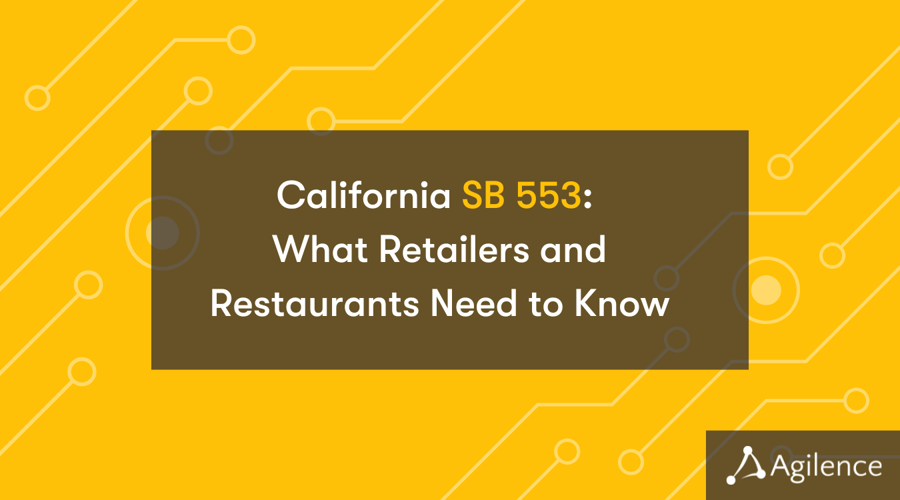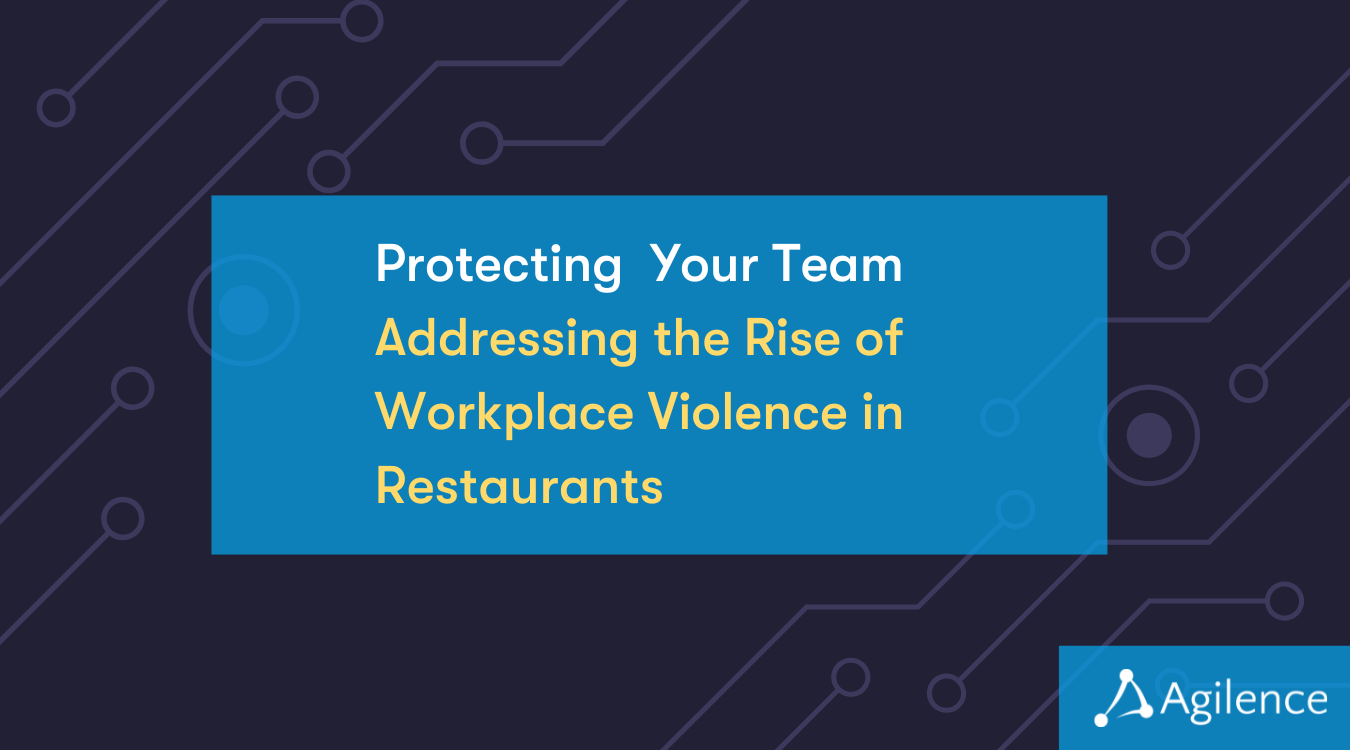What Retailers and Restaurants Need to Know About California SB 553
Retail Restaurant General
Over the past few years, the rise of workplace violence has become a major concern for retailers and restaurant operators.
State and local governments share that concern. This summer, California Senate Bill 553 went into effect, mandating that virtually every employer in the state, including those in the retail and restaurant sectors, take definitive steps to prevent and respond to incidents of workplace violence.
As often happens with new legislation, other states (such as New York with S8358) are already following to enact workplace violence laws of their own.
For loss prevention professionals, managers, and operations specialists, understanding SB 553 is paramount. Workplace violence not only endangers the well-being of employees but can also result in significant financial and reputational damage to businesses. By complying with this new law, employers can enhance their safety protocols, create a more secure environment, and mitigate potential risks associated with workplace violence.
In this guide, we will break down the essential components of SB 553, outline the steps required for compliance, and provide practical advice on how to integrate these requirements into your existing safety programs. By doing so, you can ensure that your business is well-prepared to meet these new obligations and maintain a safe, productive workplace for all employees.
What is California SB 553?
On September 29, 2023, Governor Gavin Newsom signed SB 553 into law. Effective July 1, 2024, this new law adds Section 6401.9 to the California Labor Code, which mandates that virtually every employer in the state, including those in the retail and restaurant sectors, take definitive steps to prevent and respond to incidents of workplace violence.
SB 553 was introduced in response to increasing incidents of workplace violence, particularly in high-contact industries like retail and food service, where employees frequently interact with the public. It was introduced to ensure that employees in these sectors are better protected from incidents of violence or aggression, which have been on the rise in recent years. The key objectives of the bill are to:
- Enhance the safety and well-being of employees.
- Establish clear protocols for preventing and addressing workplace violence.
- Ensure that employers are proactive in assessing risks and implementing preventive measures.
- Foster a culture of safety and responsiveness within workplaces.
SB 553 mandates that employers take a number of steps, which we explore below, such as creating a Workplace Violence Prevention Plan (WVPP), as part of their California Occupational Health and Safety Administration (Cal/OSHA) Injury and Illness Prevention Plans (IIPP). For businesses already active in California, you will be able to build on your existing IIPP framework to become compliant with SB 553.
It’s important to keep in mind that SB 553 does not grant a grace period for compliance. Employers needed to have a WVPP in place as of July 1, 2024, or face serious legal and financial consequences. Fines start at $18,000 per violation and rise as high as $25,000, with enforcement carried out by Cal/OSHA. We’ll explore compliance more below.
Who Does SB 553 Affect?
SB 553 applies to a broad range of businesses across California, with a specific focus on retailers, restaurants, and other public-facing industries where the risk of workplace violence is higher. The bill defines an "employer" broadly to include any individual or entity that employs one or more persons in California. SB 553 applies to all employers within the state of California, regardless of industry, size, geographic location, or unionization status.
If your organization operates a retail store, supermarket, pharmacy or restaurant in California, you will need to comply with SB 553. The protections under SB 553 extend to all employees within these sectors, encompassing both full-time and part-time workers, as well as temporary and seasonal staff. This inclusion ensures comprehensive coverage and protection for every individual potentially exposed to workplace violence.
Key Requirements of SB 553
SB 553 outlines several key requirements that retailers, restaurants, and other businesses in California must follow to create a safer working environment for their employees. These requirements include developing a workplace violence prevention plan, providing employee training, and maintaining a workplace violence log.
Here’s a detailed look at fulfilling the key mandates under this new law.
Workplace Violence Prevention Plan
One of the most critical aspects of SB 553 is the requirement to create and implement a workplace violence prevention plan (WVPP). This plan serves as the foundation for how your business will identify, prevent, and respond to incidents of violence or threats in the workplace.
Your WVPP should be specific to your particular workplace and integrated into your existing IIPP framework. The plan should also specify the names and/or job titles of the employees responsible for carrying out its different components.
What Should Be Included?
- Risk Assessment: The plan should outline how your business will assess the risk of violence at your workplace. This includes identifying specific situations or areas that may be more prone to violence, such as cash handling or dealing with difficult customers.
- Prevention Strategies: These strategies should focus on minimizing risks. Examples include setting up security measures like surveillance cameras, improving lighting, or requiring that multiple employees be present during high-risk tasks.
- Response Protocols: In the event of a violent incident, the plan should detail exactly how employees should respond. This could include steps like evacuating the premises, contacting law enforcement, and providing first aid if necessary.
- Reporting Procedures: Employees need clear instructions on how to report incidents of violence, whether it’s through a direct manager, HR department, or a designated safety officer.
Your workplace violence prevention plan should be regularly reviewed and updated as needed, especially if there are changes in your business operations or the physical layout of your premises. We’ll go into more detail on creating a WVPP in an upcoming blog post.
Mandatory Employee Training and Education
Another key requirement of SB 553 is the need to provide employee training on workplace violence prevention. The goal of this training is to ensure that all employees understand the risks of workplace violence, know how to prevent it, and are prepared to respond appropriately if an incident occurs.
Training Content
In order to ensure that employees are as best prepared as possible to handle situations involving workplace violence, the training program should include:
- Violence Awareness/Recognition of Warning Signs: Employees should learn how to recognize signs of potential violence, including verbal threats, aggressive body language, or escalating conflicts with customers.
- Conflict De-escalation Techniques: Training should teach employees how to calmly and safely de-escalate potentially violent situations before they spiral out of control through the use of effective communication and conflict resolution skills.
- Emergency Response Procedures: All employees must be familiar with the actions they should take during a violent incident. This includes how to safely leave the area, who to contact, and how to assist others who may be in danger. Train employees on the specific actions to take during a violent incident, including evacuation routes, lockdown procedures, and how to contact emergency services.
- Reporting Protocols: Employees should be trained on the importance of reporting all incidents of violence, no matter how minor they may seem, and how to properly document these events. Provide clear instructions on how to report incidents of workplace violence, emphasizing confidentiality and protection against retaliation.
Training Delivery
Planning and Needs Assessment
First, conduct a thorough assessment to determine the specific training needs of your workforce based on the nature of their duties and the risks they face. For restaurants and retailers, your training program should be tailored to address the unique risks and scenarios that your staff may face. The challenges faced by QSR or retail floor staff differ from those faced by a healthcare worker, so you want your training to be as specific as possible to the situations your team members might face. Customize training for different roles within the organization, recognizing that managers, front-line staff, and security personnel face different types of risks.
Frequency
Training should be conducted on a regular basis and should be refreshed whenever there are updates to the workplace violence prevention plan. Conduct initial training for all employees upon hire and provide periodic refresher courses (such as annually) to keep them informed about new threats and updated protocols. Ensure that training is accessible to all employees, including part-time, temporary, and seasonal staff, as well as those with varying levels of literacy and language proficiency.
Methods
The training should be delivered through as engaging a method as possible. Incorporate role-playing scenarios and hands-on exercises to allow employees to practice their responses to potential violent situations. Use videos, presentations, and written materials to reinforce key concepts and keep the training engaging. Engage qualified trainers with expertise in workplace violence prevention and adult learning principles to deliver the training effectively.
Compliance and Continuous Improvement
For compliance purposes, be sure to maintain detailed records of all training sessions, including dates, attendees, and the specific content covered. Regularly review training records to ensure compliance with SB 553 requirements and identify any areas needing improvement. Establish mechanisms for employees to provide feedback on the training program, allowing for ongoing refinement and enhancement.
Maintaining a Workplace Violence Log
In order to comply with SB 553, businesses are also required to maintain a workplace violence log. This log serves as an official record of any violent incidents that occur at your business, allowing you to track patterns and address areas of concern.
What Should Be Included in the Log?
- Incident Details: For every violent event or threat, the log should record the date, time, location, and individuals involved.
- Description of the Event: Provide a clear, factual account of what occurred, including any injuries sustained or property damaged.
- Response Actions: Document how the incident was handled, including whether law enforcement was contacted, and any immediate actions taken to protect employees and customers.
- Follow-Up Measures: Detail any follow-up steps taken, such as additional training, changes to the workplace violence prevention plan, or disciplinary actions against the individual(s) involved.
Keeping an accurate and up-to-date log is not just a requirement for compliance but also a critical tool for identifying trends in workplace violence. This information can help you make informed decisions about improving safety in your business.
Agilence Case Management provides an effective solution for maintaining a compliant workplace violence log under CA SB 553, giving users a centralized platform where businesses can securely document and manage workplace incidents, including detailed records of violent incidents, responses, and follow-up actions. The platform enables seamless tracking, retrieval, and sharing of records, helping businesses meet the log requirements.
Reporting Requirements
In addition to maintaining a log, SB 553 requires businesses to report certain incidents of workplace violence. Internal reporting can be made through a tool such as Agilence Case Management, with the incident details recorded on the ground by staff through the web portal, moved to appropriate internal users, and then exported to be shared with state authorities.
Who to Report to:
- Certain serious incidents, such as those resulting in significant injuries or involving weapons, may need to be reported to regulatory agencies like Cal/OSHA.
- Reporting must also be made internally to relevant departments, such as HR or a designated safety officer.
How to Remain Compliant with SB 553
Non-compliance with SB 553 can be expensive for retailers and restaurants. Fines can range from $18,000 to $25,000 per violation. The exact amount depends on the nature of the violation, the size of the business, previous safety records, and efforts to correct the violation.
However, fines aren’t the only penalties. Noncompliance can also lead to Cal/OSHA revoking a business’s license and can even lead to a misdemeanor charge. It can also mean a weaker defense in any legal claims related to workplace violence.
It’s better to stay compliant. And as other states adopt similar laws, they’ll likely use similar requirements – so if your organization has locations in multiple states, starting now will give you a head start on future compliance too.
The first step is to conduct a workplace safety audit. Start by assessing potential risks specific to your business. Look for areas where employees might face increased risks, like cash handling points, stockrooms, or customer interaction areas. Agilence Store Audit enables you to easily create and execute audits.
Document your findings and use them as the basis for your workplace violence prevention plan. This risk assessment should be an ongoing process, as business operations and layouts change over time. Then, work on developing and implementing your workplace violence prevention plan and employee training sessions.
Agilence Case Management provides everything necessary for a workplace violence log. Case Management allows you to track any incident, including the date, time, and incident description, as well as any response actions taken, in a fully compliant way that can easily be tracked and shared with authorities.
Overcoming Common Compliance Challenges
Many businesses face challenges when implementing SB 553’s requirements. Below are some common issues and tips for overcoming them:
- Keeping Up with Training: For busy retail and restaurant environments, scheduling consistent training sessions can be difficult. Consider offering flexible training formats, such as online modules, to make it easier for all employees to complete their training.
- Tracking and Managing Logs: Maintaining an accurate log of workplace violence incidents can be time-consuming. Using Agilence Case Management can help streamline this process, making it easier to keep records and access them as needed.
- Staying Updated on Requirements: SB 553 may evolve over time, with amendments or changes in reporting requirements. Assign someone to monitor updates from Cal/OSHA or other relevant regulatory bodies to ensure ongoing compliance with any changes to the law.
Frequently Asked Questions (FAQ) About SB 553
Who is exempt from SB 553?
The majority of California employers must comply with SB 553, with the exception of employers with fewer than ten employees who are not open to the public and employees who are teleworking from a location not under the employer's control.
What must be kept for 5 years under SB 553?
Workplace violence hazard identification, evaluation, and correction records; violent incident logs; and workplace records of incident investigations must be kept for at least 5 years. Employers must also keep training records for a minimum of one year.
What are the requirements for SB 553 training in California?
Employers must provide annual workplace violence prevention training to all employees covering topics like the company's Workplace Violence Prevention Plan (WVPP), how to report incidents without fear of retaliation, workplace violence hazards specific to their job, strategies to avoid physical harm, and how to access a copy of the plan.
Why was SB 553 created?
SB 553 was created in response to a general rise in workplace violence across the nation as well as a number of tragic workplace violence incidents, such as a 2021 incident at a Northern California railyard which resulted in nine deaths.
Is there a grace period for SB 553?
No, there is no grace period for SB 553. The law went into effect on July 1, 2024, and employers were required to have a workplace violence prevention plan (WVPP) in place by that date.
What must the SB 553 incident log include?
The workplace violence incident long must include:
- The date, time, and location of the incident
- A detailed description of the incident
- The type of incident, such as physical, verbal, sexual, or animal attacks
- Who committed the violence
- The circumstances of the incident, such as whether the employee was performing job duties
- The consequences of the incident, such as if medical treatment was needed or if law enforcement was contacted
- The contact information of the person who completed the log
What is the SB 553 restraining order?
SB 553 expands the ability of employers to seek temporary restraining orders (TROs) for employees facing credible workplace violence or threats.
What is section 6401.9 of the labor code?
California Labor Code section 6401.9, also known as Senate Bill 553 (SB 553), is a law that requires employers to prevent workplace violence.
What is workplace violence in general industries (non-healthcare settings)?
According to LC 6401.9(a)(6), workplace violence includes any act or threat of violence that happens at a place of employment. This can range from physical force that causes injury or psychological trauma to threats involving weapons, even if no injury occurs.
Are there specific requirements for how incidents should be reported?
Yes, SB 553 requires that employers establish a straightforward and confidential system for employees to report incidents of workplace violence. Employees should be informed about this system and assured that they can report without fear of retaliation.
What records must be kept to comply with SB 553?
Employers must maintain detailed records of:
- Risk assessments and findings
- Training sessions, including participant lists and content covered
- Reported incidents of workplace violence and actions taken in response
- Investigations and follow-up measures
- Updates and revisions to the WVPP
Related Articles

Protecting Your Team: Addressing the Rise of Workplace Violence in Restaurants
The rise in workplace violence has become a major concern for restaurant owners and operators. A survey conducted by the Nati...
5 Tips to Improve Restaurant Performance
Table-service restaurants serve as a reunion or gathering spot for family, friends and coworkers alike, while quick-service e...
10 Topics to Include in your Retail Business Health and Safety Manual
An up-to-date safety manual is essential to keep employees, customers, and your business safe from harm. Instead of just keep...Subscribe to our blog
Receive free educational resources like exclusive reports, webinars, and industry thought leadership articles straight to your inbox.

